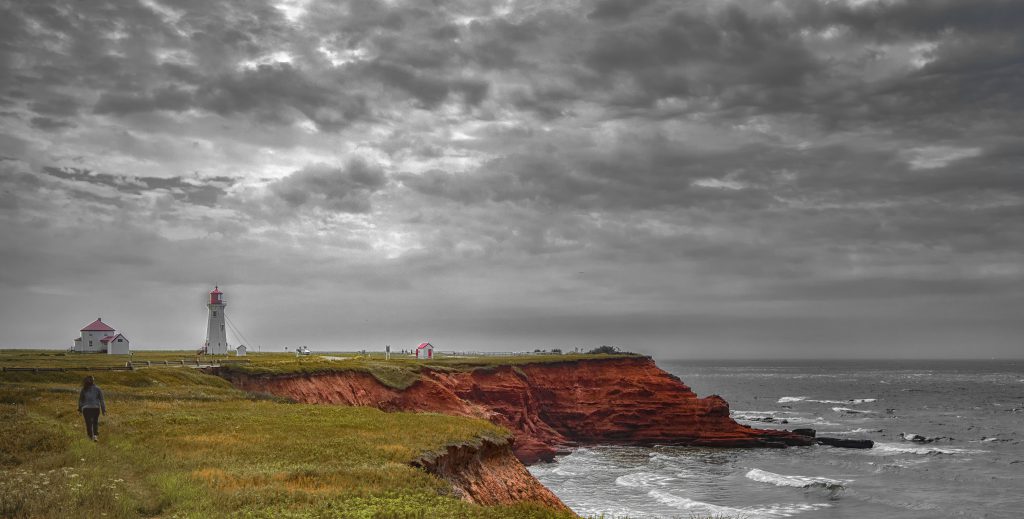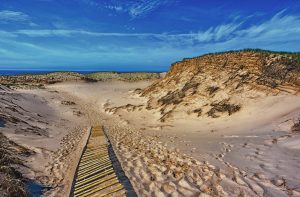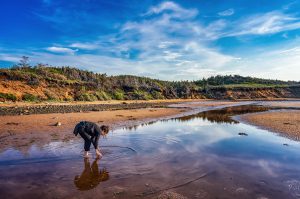 Featured in September 2018 issue of Forever Young
Featured in September 2018 issue of Forever Young
When I was booking my flight to the Magdalen Islands, my travel agent told me I should be at the airport 2.5 hours early because she thought I was taking an international flight—from Toronto. As I was soon to learn, many people are unfamiliar with this beautiful part of Quebec, not just within Anglophone Canada but in the rest of the province as well.
The Magdalen Islands (or Îles de la Madeleine) are an archipelago of a dozen islands, seven of which are inhabited, and six of which are joined by a long strip of sand dunes, which take almost two hours to drive across. These islands are located far out in the Gulf of St. Lawrence, and— despite being a part of Quebec—are so far from the Quebec mainland that they are a time zone away, and closer geographically to P.E.I.and Nova Scotia.
But they are quite accessible—most easily by flying through Montreal or Que- bec City to an airport on the islands, or via a five-hour ferry from Souris, P.E.I.Their unique geography and location make them a distinct feature in Quebec.Come if you are a nature lover, and like to hike, bike, kayak or swim in caves; if you are a foodie, and enjoy fresh seafood, local cheeses and seal; or if you like the beach. Sixty per cent of the islands’ 385 kilometres of coastline are sandy beaches, with dunes stretching out as far as the eye can see.
I came for all these reasons, but also because I appreciate wide open spaces and am enamoured of the islands’ colourful houses — purple, aquamarine, bright yellow, pink, green – that dot the landscape everywhere, sometimes clustered together in villages, other times standing alone atop a hill. Here there are few trees and many rusty red cliffs with natural caves formed by the ocean current and strong winds that are such a feature of the islands.
THE NORTH
Wildlife, lobster and dunes

We started our trip at the Auberge la Salicorne on Grande Entrée, which is the last island you reach heading northeast along the chain. The auberge is a perfect place to stay for fami- lies because of its all-inclusive packages, evening entertainment (which includes a weekly singer and a fisherman/storyteller). and many activities. From here you can do yoga, go clam digging, kayaking, swimming in caves,“clay bathing” on near- by Boudreau Island and hiking.

We did a guided hike along L’Échouerie, a nature interpretation trail on the nearby 724-hectare East Point National Wildlife Reserve, and a haven for birdwatchers. A short hike brought us along sandy paths, through stunted forest, and out into open dunes.Our guide Rosie Rankin explained how the sparse wisps of beachgrass are “the skeleton for our sand dunes,” their roots helping to prevent erosion.We came to a large concave indent in the sand aptly named the“Bol de Soupe”(or soup bowl).
The coastline of the reserve is Old Harry Beach, a stunning 8.5 km stretch of sand that National Geographic named one of the best beaches in the world.With sand, wind, beach and stillness, It’s a haven for kite surfers and picnickers alike. In early July, the water is still cold for swimming, but it’s perfect for a long walk and to wander the red cliffs at one end. It’s all about wide-open spaces.
Grande Entrée is also the lobster capital of Quebec, with 115 lobster-fishing boats taking part in the nine-week season this year. On Cap Dauphin in nearby Grosse Ile, you can wander down to the harbour, and watch the fishermen sorting and off loading bins of the lobster, and then gorge on lobster rolls at the Fish Shack restaurant.
Grosse Isle is also the destination of the one-room Little Red Schoolhouse,built in 1921, and the adjacent Veterans’ Museum. This small museum, honouring the 332 islanders, or Madelinots, who fought in the Second World War (23 of whom never returned), is well worth a visit for the guide’s heartfelt stories about the veterans. The schoolhouse and museum form part of the Council of Anglophone Magdalen Islanders (or CAMI), which is a non-profit organization created to protect minority rights of the 700 Anglophones still living on the islands.
THE MIDDLE ISLANDS
Urban and rural, fine food and a luxurious inn
If you were to describe a“downtown”on the Magdalen Islands, you would find this on Cap Aux Meules (or Grindstone Island),with its many businesses and stores, a hospital, and a range of places to stay. The island also has several good restau- rants,including Les Pas Perdus,where you can also hear live music. Cap Aux Meules is also the port of entry/departure for year- round ferries to Souris, P.E.I. and for the 10 km trip to Ile d’Entrée, the Magdelan island accessible only by boat.
But step away from its more urbanized core, and you will find much more to dis- cover on this island.We rented bikes one day at Le Pédalier, and did a 30-km bike around the island, mostly on secondary roads, but often with clear views of the water. The ride included stops at Borgot lighthouse, and later to eat lunch at the lovely seaside restaurant Café la Côte, where we had their delicious mussels with a sauce made from their local Pied de Vent cheese.
L’Étang-du-Nord on the west of the island is the location of the Parc de Gros- Cap, where you do kayaking tours (wind permitting) and then stop by for a smoked malt at L’Abri de la Tempête, a microbrew- ery with a fun vibe and great seaside views. It is also here on L’Étang-du-Nord where we had our best dinner of the trip at La Table des Roy, a cozy house (and former family home of its chef and owner) that has trans- formed into upscale restaurant.
Choose from their table d’hôte menu featuring items either from la mer (sea) or la terre (land), or an excellent à la carte menu. We loved their fresh seared tuna, lobster ravioli and seafood paella.
In the same standards of luxury is the nearby Domaine du Vieux Couvent on Havre aux Maisons, a 100-year-old convent turned inn—its 11 rooms offering extraor-dinary views of the sea, and billowy white duvets promising a cozy night’s sleep.With high ceilings, hardwood floors and a combination of historic and modern,this is true luxury.Only five minutes from the airport, and easily the most upscale accommoda- tions on the Magdalens, rooms get booked up quickly, so reserve early.
Also on Havre aux Maisons is the glass-blowing studio, Verrerie la Méduse, the Fro- magerie du Pied de Vent—a working farm and cheese factory, and Le Fumoir d’Antan, the last remaining smokehouse on the islands. Although herring is no longer fished on the Magdalens, 30,000 pounds are shipped from New Brunswick each year, soaked in brine, and then hung from racks on the ceiling of their smokehouse to dehydrate before being fileted and skinned by hand.
While on the islands, you will likely also drive through Pointe aux Loups, which is the smallest inhabited island with only with only about 50 houses and great beaches.
THE SOUTH ISLANDS
Tranquil, forested and sprawling
Havre Aubert in the southern portion of the islands has a distinctly quieter feel, and is the island where the Acadians first settled. Here la Grave (meaning pebble beach), designated a historical site in 1983, is the feature attraction. La Grave was the ‘port d’entrée” of the islands, where people first settled, and until the 1950s, was the heart of commerce, and the gathering places for fishermen and other locals as well as travellers coming to the islands.
This narrow strip of land next to a harbour is now lined with many boutiques, cafés, galleries and restaurants. Stop by Café de la Grave, a former general store, to hear live music, enjoy seafood pie and chat with locals in the same spirit of gathering inspired by original settlers.And visit the Artisans du Sable, or sand economuseum, to learn about the 15 different types of sand on the island, and other interesting facts.
Just off the strip is Auberge Chez Denis à Francois, a charming 14-room inn with a laid-back vibe, and high end dining. For us, staying here was like being hosted in a favourite grandmother’s house. About 15 minutes away by car is l’Anse à la Cabane lighthouse ,which was built around 1870 and is worth a visit for its location alone, with a view of a cove, and a fishing port and the Magdalens’ famous red cliffs.
If You Go
By car: Car ferries from Souris, P.E.I. take about five hours and book up early, so reserve ahead.
By plane: Both Air Canada Jazz and Pascan Aviation fly to an airport on Havre-aux-Maisons,
By cruise ship: CTMA Cruises offer an eight-day cruise, departing from Montreal that operates from June 15 to September 7. See www. croisieresctma.ca/en/ for more information.
Planning a visit? View www. tourismeilesdelamadeleine.com/en/